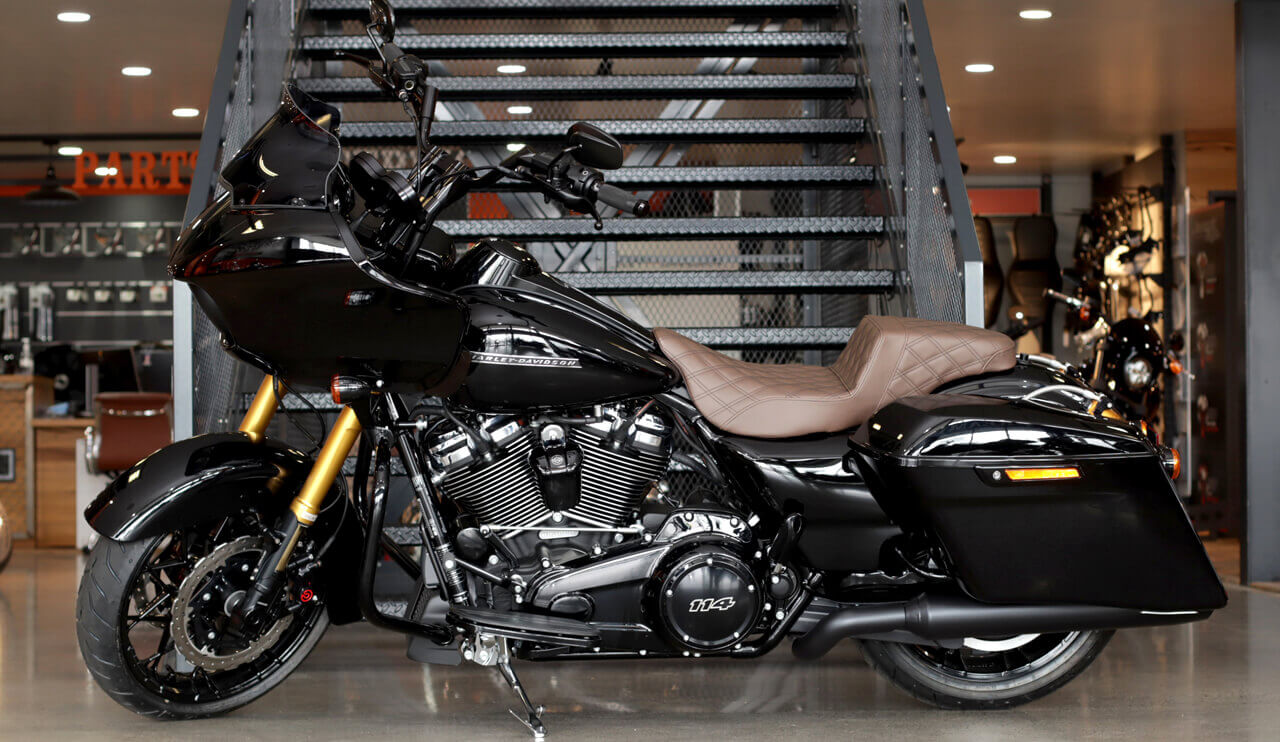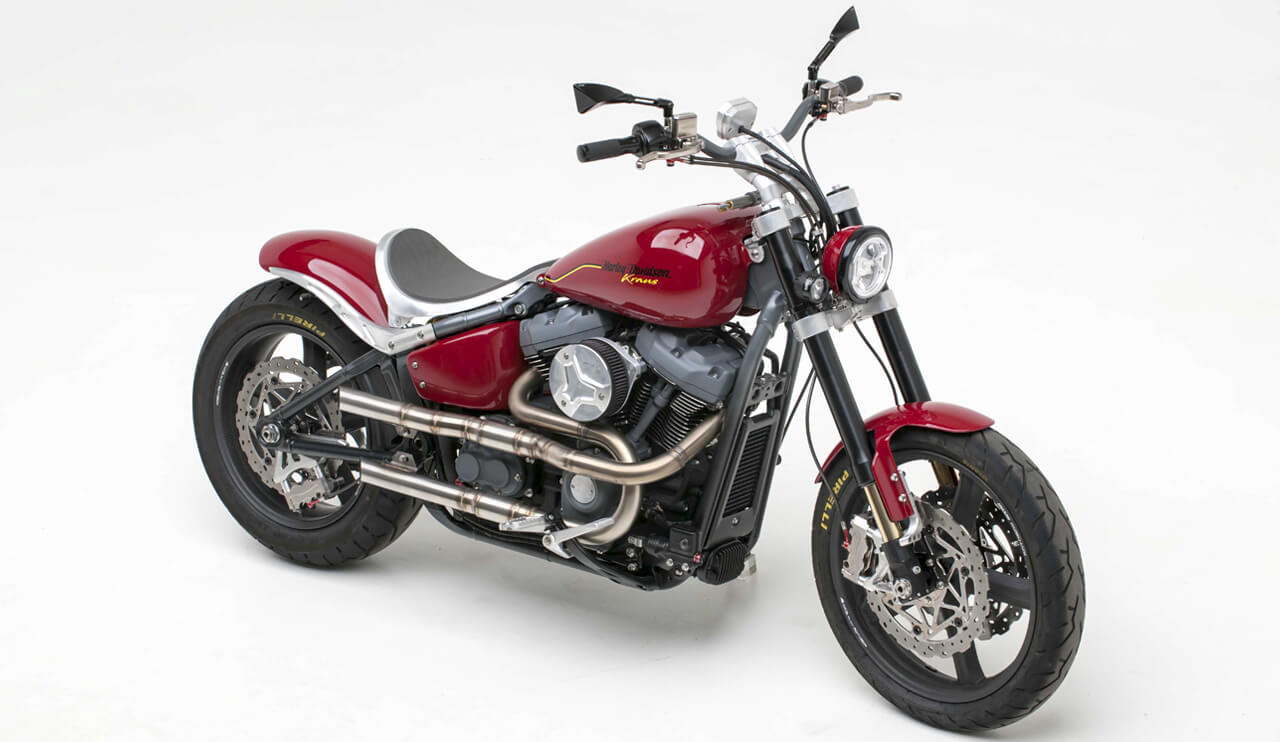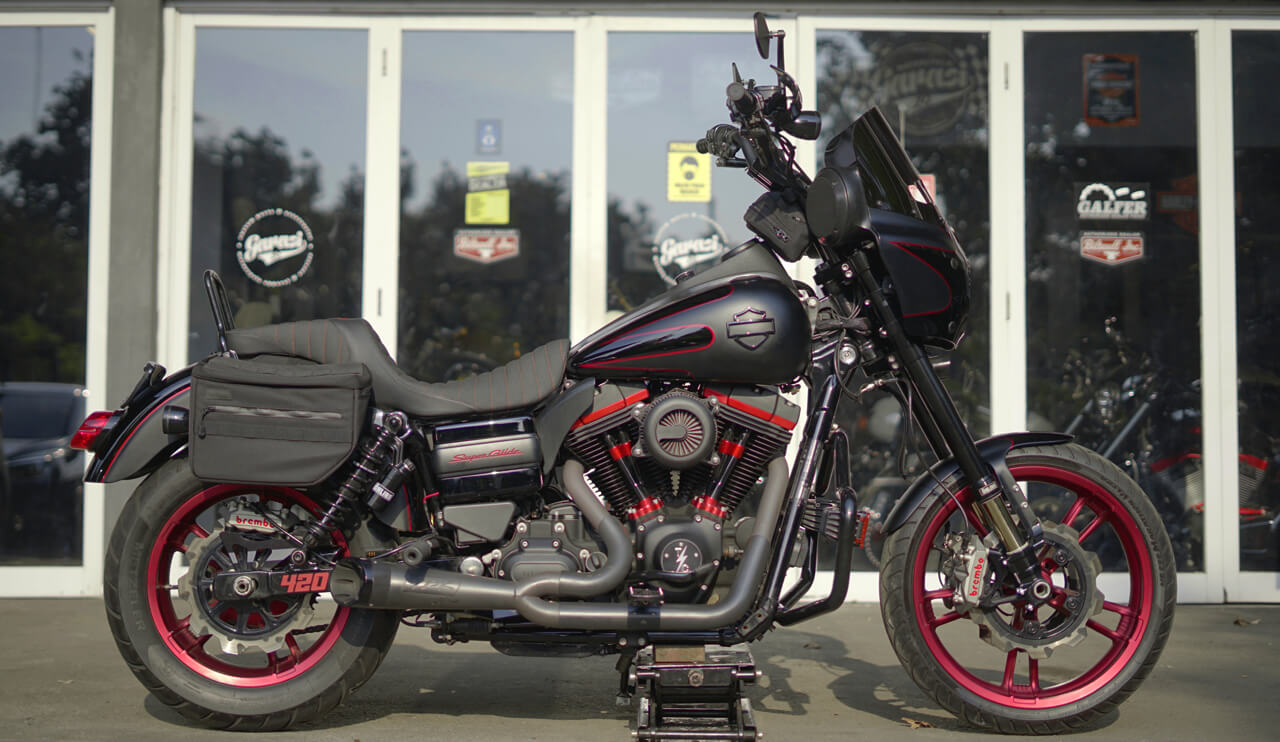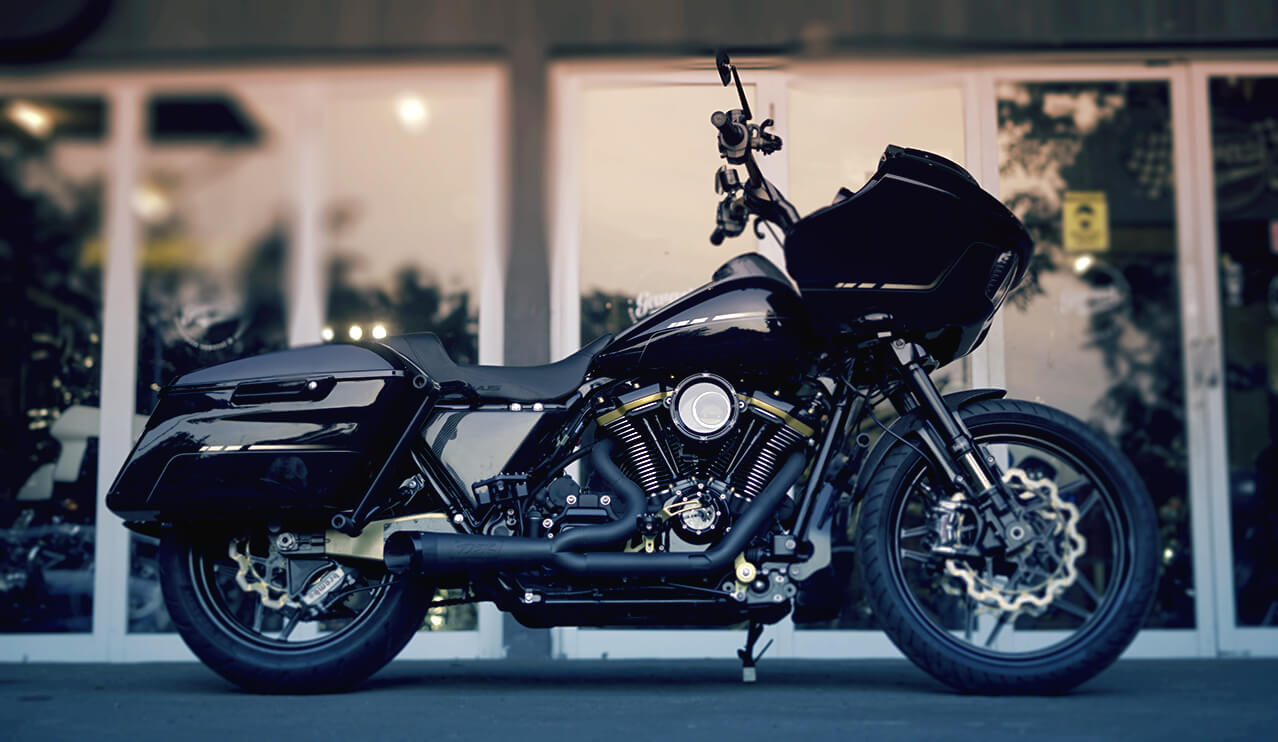Making Harley-Davidsons faster and squeezing as much performance as possible out of them has been a part of the brand (and American culture) since the company was founded in 1903.
From the board track racers of the early days to the drag racers and baggers flying around racetracks today, Harley-Davidson and performance go hand in hand.
Kraus has been a leader in the field of high-performance Harleys, thanks to our expert craftsmanship and attention to detail, but we choose to tune Harley-Davidsons because each model we touch has a rich history of performance, and we want to leave our mark in the history books.
At Kraus, we specialize in tuning Baggers, Softails, Sportsters, Dyna, and FXRs. And to appreciate where we’re going with these models, we need to know where we’ve been.
In this article, we’re going to take a look back at these five model lines and trace their lineage, paying special attention to how each has its own unique history when it comes to going faster, handling better, or otherwise performing beyond what the folks in Milwaukee ever dreamed of.
Bagger
We start with the model nobody ever thought would be a canvas for modification (at least not like this).
But maybe that’s exactly why the performance bagger craze is so hot and heavy. If you haven’t heard of the King of the Baggers series, go check it out. MotoAmerica, the national pro-level road racing organization, has a class dedicated to performance baggers.
It stemmed from a single event at Laguna Seca spearheaded by Roland Sands. The reaction to it was so popular that we’re now seeing the class expand to several different locations, and the likes of Harley-Davidson and Indian are building factory-supported bikes and riders to compete. It’s really the pinnacle of bagger performance.
The bagger performance craze now seems wild to imagine from the bagger’s humble beginnings in the late 1950s and early 1960s. Back then, the FL platform in the shape of the Duo-Glide was Harley’s attempt to entice people to go out and tour.
The mid-1960s saw the introduction of the Electra-Glide as the last change to the FL platform, with revisions to the suspension and innovations like electric start. But they also had windscreens and saddlebags to make long-distance cruising more manageable.

While these bikes focused more on touring and comfort, their weak point was the engine. The Panhead eventually gave way to the Shovelhead, which later was replaced by the Evolution and Twin Cam engines, but through it all, those engines were underpowered and weak. This opened the door for tuners and backyard mechanics to squeeze out whatever power they could.
We could write a whole post just on different engine modifications done to the bagger over time, but you get the point. Throughout the years of tuners getting more power, however, very little was being done to make the rest of the bike perform any better. Suspensions were still bad, brakes were a little scary, and the frames would flex like silly string. None of those are traits you want in a performance bike.
It wasn’t until the 2000s that Harley started to take bagger performance a little more seriously. The introduction of the Street Glide was one step. Upgraded suspension and engine mounting direct from the factory was another. Project Rushmore ushered in a new era for Harley in 2014 and paved the way for the craze of performance baggers we see today.
At Kraus, we could see a gap forming. Several companies focused on making power, but very few focused on the rest of the bike. Suspensions still needed help, and there were few options to make these heavy bikes – that were now getting faster – slow down any better or feel any more comfortable.
When it comes to completely transforming the bagger, Kraus’ inverted front-end kit is itself a monumental change. Pair it with Öhlins shocks, BST wheels, and big, upgraded brakes, and you have something you can take to the racetrack, drag strip, or just to your local hangout. No matter where you take it, it’ll turn heads and impress with its looks AND its performance.
Softail
There was a time when Harleys didn’t have shocks in the back – or any rear suspension at all! The rear wheel was solidly mounted to the frame, earning it the name “Hardtail.” For as tough as riders were back in the day, the human spine can only take so much abuse. An early solution (which we still see today) to help make the ride more comfortable was to suspend the seat itself on springs to dampen vibrations.
It helped, but the real genius was affixing a shock to the rear while still giving the appearance of a Hardtail. This was done by hiding the shock under the bike instead of having two on the sides in plain sight. The idea had been around at least a decade prior (and rear suspension even longer before that), but in 1983 Harley-Davidson FXST Softail was born, the first production Harley meant to mimic the look of a Hardtail while having the benefits of rear suspension.
Customization of the Softail (and its many copycats) has taken off ever since. From mild to wild, Softail's blank canvas has spawned its own industry in upgrades that eventually led Harley-Davidson itself to offer accessories straight from the factory.

To date, there have been 132 different variations of the Softail—and counting! The Softail is legendary among the motorcycling fraternity, but perhaps the model that stamped itself into modern pop culture is the FLSTF ridden by none other than Arnold Schwarzenegger in the 1991 hit movie Terminator 2: Judgement Day.
For such a popular motorcycle, there’s seemingly no end to modifications that can be done to the Softail. Engine modifications and even engine swaps are popular and common, but the possibilities are endless. From mild to wild, the Softail has seen everything from bright paint and huge chrome wheels to subdued graphics with hidden performance brought on by proper suspension, big brakes, and an aggressive stance.
At Kraus, we know how to make Softails look good, feel comfortable, and perform beyond your wildest dreams. From riser kits and carbon fiber fenders to Softail forks and springs from some of the most trusted names in the industry.
Sportster
Has there ever been a more versatile motorcycle than the Harley Sportster? From the dawn of time, it seems if there was ever anything you needed to do on two wheels, the Sportster was the machine to do it on.
Introduced in 1957, the first Sportsters came with an 883cc air-cooled OHV (Over Head Valve) V-Twin, which proved to be a better performer than the flatheads before it with side valve heads. This increase in performance, combined with its smaller stature (at least compared to other Harley models), endeared it to so many and contributed to its versatility.
Over the years, much of Harley’s racing success could trace its roots back to the Sportster in one way or another. This includes flat track racing, where Harley’s racing dominance spanned decades thanks to the XR750, which, yes, has its lineage rooted in the Sportster.
Engine size steadily increased in the Sportster, as a 1100cc version later joined the original 883cc engine. That engine would eventually grow in size to 1200cc, but that’s as far as it went for the Sportster. After that, a big performance change was the switch to electronic fuel injection instead of carburetors, but in the mid-2000s, the motorcycle landscape started to change.
Bikes were getting more focused and built to specific categories, and the “Sport” in Sportster was starting to lose some of its meaning. Not much came down the pipeline as far as performance for the Sportster.
Instead, Harley turned its attention to churning out as many different variations as possible, all with the same 1200cc V-Twin. After serving several decades in service and in continual production (perhaps longer than any other motorcycle), the Sportster name moved to an all-new platform.
The Sportster S is the most advanced Sportster to date, with Harley’s latest engine, the 1250cc Revolution Max, complete with liquid cooling, four overhead valves per cylinder, and everything else. But we’re not focusing on that.

Instead, let’s look back on over 50 years of performance on the old Sportster platform. While this bike was customized for looks and show just like every other Harley, the Sportster has a place in the hearts of performance junkies especially.
Getting the most out of the 1200cc V-Twin—and not just swapping it out for something else—is a point of pride. Everything from land speed records to road racing to flat track and even hill climbs was done with the Sportster, which should tell you all you need to know about how versatile it is as a performance canvas.
At Kraus, our inverted fork kit, drop trees, and shock packages will get the Sporty handling better than ever. Pair that with our Sportster big brake kits and carbon fiber wheels, and you’ve got yourself one amazing Sportster that will go, turn, and stop better than even the designers at Harley-Davidson could imagine.
Dyna
Avid television watchers will recognize the Dyna from the hit series Sons of Anarchy, where various Dyna models were featured prominently within the show. But Harley heads will know the Dyna really made its debut 17 years earlier. Or did it?
While yes, the first official Harley Dyna, the FXDB Sturgis, was introduced in 1991, many say the first Dyna was really born 20 years before that—in 1971. Then, Willie G. Davidson drew up the FX Super Glide, merging the sporty front end of the Sportster with the touring frame of the Electra Glide. Suddenly, there was a touring platform that could actually handle, with a look that would catch on.
Harley released different versions of the FX throughout the 1970s, then updated to the FXR Super Glide II in 1982, with the big difference being a rubber-mounted engine and five-speed transmission replacing the solid-mount and four-speed of the FX. The FXR completely supplanted the FX by 1987, leading to the official announcement of the first Dyna only four years later.
A fitting name for a new model, the FXDB Sturgis is credited as the first official usage of the Dyna name and was made in limited quantities. The FXD chassis would prove to be stiffer than its predecessor and that was well received, not least because it could handle the power from Harley’s newly released Evolution engine.
Still, the essence of the Dyna came from the elastomer mounts that gave the bikes their “rubber soul.” The rider could still feel the engine vibrations, but it didn’t rattle their teeth loose at cruising or highway speeds. In addition, the Dyna became known as the performance Big Twin (as opposed to the Sportster’s small twin) with twin rear shocks that clearly separated it from the Softail. It forged an identity all its own.

By 2006, the FXDBI Street Bob and FXDI35 35th Anniversary Street Glide also brought with them a six-speed gearbox and a new chassis, and by 2008 we get the Dynas real breakout moment – its television debut on Sons of Anarchy, which propels the line into the limelight for the show’s seven seasons.
In 2017 Harley announced the end of the Dyna for the following year. Dynas lost the twin shocks and would eventually be absorbed into the Softail line. Reasons abound for why the Dyna was killed off, but its long legacy—and abundant availability in the used market—means its going to live on for quite some time.
This is great, because Kraus specializes in making Dynas perform in ways you never thought imaginable. From getting the bars right where you want them to adding proper Dyna suspension and brakes, Kraus has the Dyna covered.
FXR
It’s funny that the FXR comes after the Dyna in this story because, as you probably well know, the FXR is actually the precursor to the Dyna. It’s also still regarded as one of the best bikes Harley ever made. But it didn’t start that way.
Introduced in 1982, the FXR was released at a time when competition from Japan was coming in hot and heavy. Technologically, the Japanese competition was outpacing Harley with bikes that rode better and were more reliable. Harleys felt ancient by comparison. The FXR was Harley’s answer. On paper, it answered the call for a better bike. In reality, at least at first, it lost a lot of the Harley charm.
This time period was also significant because Harley had just completed its buyout from AMF. There was urgency to right the ship, and the FXR was one of the first models to be released. It had to be right. It also meant there weren't huge resources to design an all-new bike, so the FXR shared a platform with the FLT Tour Glide and its elastomer engine and transmission mounts.
Still, the Tour Glide platform wasn’t quite right for the job, requiring an all-new frame that was designed by one Erik Buell (and we all know what he went on to do after his Harley days). It wasn’t cheap, as it had to be welded by hand (this was before robotic welding), but it was quite the deviation from past Harleys—as in, it actually handled well. The thick seat put the rider higher than one would expect from a Harley, which contributed to the sporty feel. It also housed the battery and oil tank underneath.
Three disc brakes, an isolated powertrain, and a five-speed transmission instead of four all combined to make the FXR the sporty machine the engineering team was going for.
Variations on the FXR came hot and heavy after the initial launch, with FXRT, FXRP, FXRS, FXRC, FXRD, FXLR, and FXRS and FXRS-SP models coming one after another in successive years starting in 1983. Harley was trying to cash in on the FXR in the 1980s, but enthusiasts and fans felt like Harley had “jumped the shark” and lost its way with so many variations over such a short amount of time.
By the 1990s, the FXR went away, and the Dyna was introduced, although the FXR did make a brief comeback in 1999 as a limited edition CVO model. The FXR2 was followed by the FXR3, and in 2000, the chapter was shut for good with the FXR4.
Despite the fact the FXR has been discontinued for over 20 years, its popularity is still too large for Kraus to ignore. This is why we offer a variety of parts to keep it true to the sporty nature in which it was built to begin with. Could you have imagined the original designers and engineers, including Erik Buell, seeing the FXR with inverted forks, big brakes, and carbon wheels?
As you can see, despite their apparent similarities on paper, the different Harley models really have a unique history all their own with performance potentials tuners have been taking advantage of since the beginning. At Kraus, we realize and respect this heritage.
Hopefully now this guide gives you a better understanding of the different types of performance Harley models and why we cater to them. If you’ve been wanting to upgrade your Bagger, Softail, Sportster, Dyna, or FXR, don’t hesitate to contact us. Let’s just say we know a thing or two about all of them.



